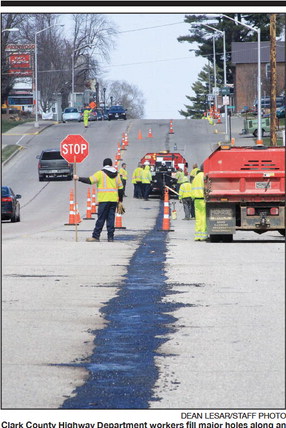Greenwood Main Street patch job expected to last until 2024-25 project


The Clark County Highway Department is conducting a major patching operation on Greenwood’s Main Street that is expected to carry the 1-mile stretch through to a more significant Highway 73 repaving project in either 2024 or 2025. The work is being totally funded by state Department of Transportation annual maintenance dollars and is seeking to temporarily correct premature asphalt deterioration problems from a 2006 Main Street reconstruction job.
Clark County Highway Commissioner Brian Duell said Monday that crews would need a few more days to clean out and refill significant holes that have developed along almost the entire length of Main Street through Greenwood’s downtown. The holes formed in the last several years mainly along asphalt seams between the main traffic lanes and parking lanes, with some also developing in the main traffic areas. An attempt was made a year ago to patch the seams with asphalt material, but that quickly loosened and popped out of place due to weather and traffic.
After the city of Greenwood asked DOT and other state officials over the winter for a more permanent solution, the DOT ordered the deteriorated areas to be filled with a mastic patch material. Duell said it is a newer method of repairing asphalt trouble spots that are too large for normal pothole patching methods, but not large enough for asphalt overlays.
Clark County highway crews are doing the work because the DOT contracts with each county in the state for maintenance on the state trunk highway system. Greenwood’s Main Street is on Highway 73, and the state is responsible for maintaining the center 22 feet of roadway. The city is responsible for the parking lanes, but Duell said little deterioration occurred there.
Duell said Jackson, Wood and Marathon counties have been using mastic patching techniques in recent years, with positive results. Clark County is using the method for the first time in Greenwood, and, in fact, purchased a new melting machine that will be used around the county for future needs. Duell said the mastic material is not a rubberized patch that can more easily be pushed out of a pothole by frost, water, or weight. “It’s actually a patching material that has asphalt and aggregate stone in it,” he said. “It melts down in there and forms to whatever void you have.”
The patch material comes in blocks that are loaded into the machine and then melted at 380 degrees. At that hot temperature, it is then poured into the holes, where it hardens and creates a tight seal. The holes are first scoured out with highpressure air and a primer is then sprayed on to promote adhesion.
Duell said it’s a more costly process, but should create a longer-term repair.
“That void is far too much for rubber crack fill material,” he said. “Rubber crack fill material would pull out of there. That’s what this type of material is used for.”
“It’s actually a patching material that has asphalt and aggregate stone in it. It melts down in there and forms to whatever void you have.” -- Clark County Highway Commissioner Brian Duell
DEAN LESAR/STAFF PHOTO Duell said DOT officials are not certain why the area along the seams where two layers of asphalt meet crumbled after only about a dozen years. With a major resurfacing of Highway 73 from the Rock Creek bridge on Greenwood’s south end to Highway 29 not included in construction plans until 2024 or 2025, something more permanent needed to be done. The DOT looked at various options, and determined the mastic material would be the best to both fix the problem yet not commit an undue amount of money to a stretch that will be replaced in a few years.
Duell said the work is significant, as the asphalt along the seams has crumbled to the point where wide and deep gaps are common.
“It’s a big project for patch material like that,” he said. “It’s taking a lot more material than we had anticipated. There’s a lot of void there. It’s the right product for that, but it’s a lot of it.”
Duell said the DOT did not allocate any new non-budgeted dollars for the Greenwood work. It gives the county a set amount of money each year to conduct maintenance over the 150 miles of state roads that transect the county, and this work will eat up a good amount of it.
“We’re working with the same amount as we usually do,” Duell said. “Whatever we spend on that just comes out of our yearly allotment.”
The county bought the mastic material melter and is using it for the first time in Greenwood, although it was a budgeted purchase anyway and will be used wherever it is needed in the future.
“Patching potholes is a never-ending situation,” Duell said.

